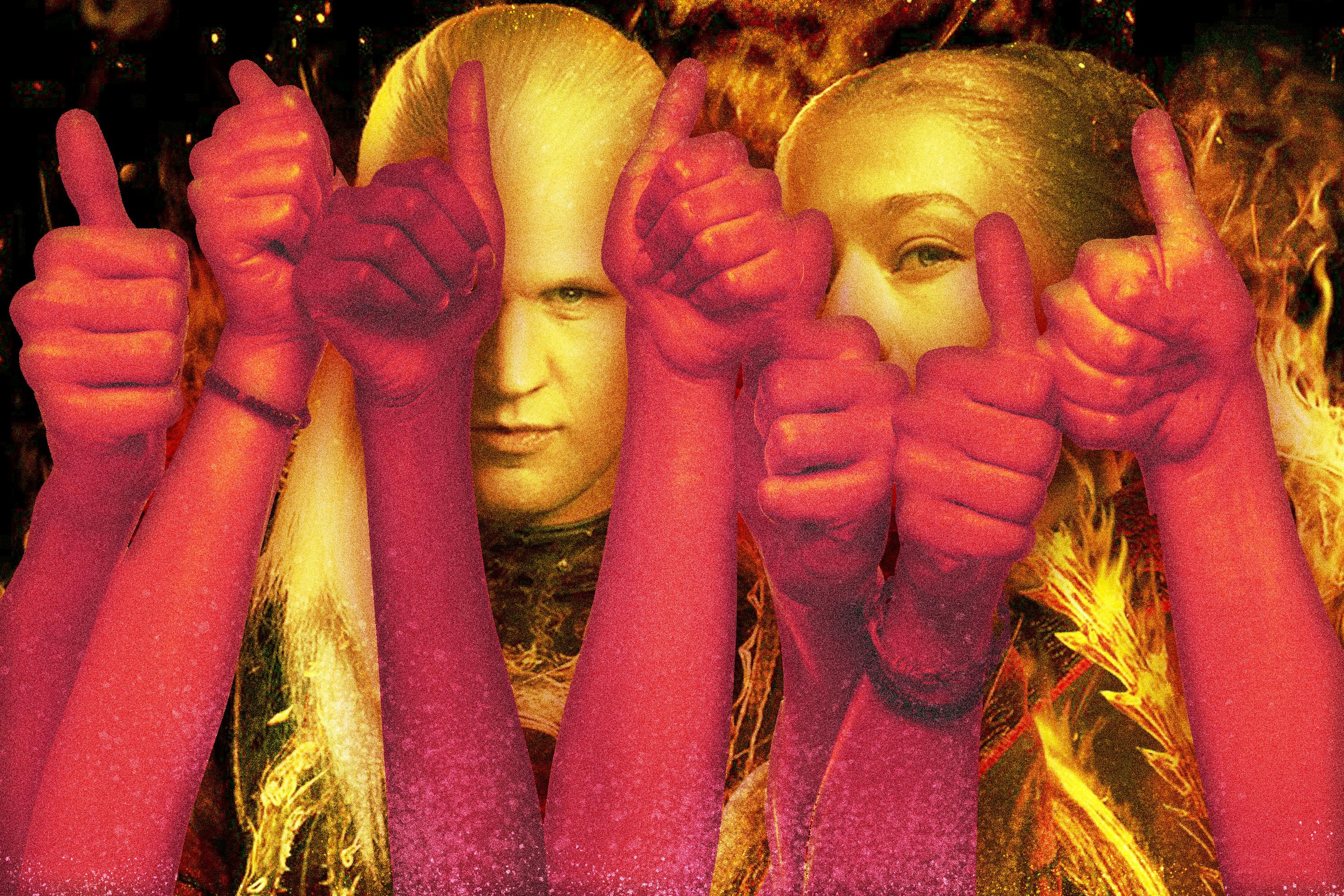Get in, Losers, We’re Being Optimistic About ‘House of the Dragon’
The end of ‘Game of Thrones’ left a sour taste in everyone’s mouths. But those days are over, and the (very near) future looks bright.
I’ve been thinking recently about the Iron Throne from House of the Dragon. Have you noticed that it’s different from the one in Game of Thrones? Just take a look—here’s the throne you’re probably most familiar with:
And here’s the new (or, uh, old throne) that will appear in House of the Dragon when it premieres on August 21:
Rest in peace to Littlefinger’s speech about the Iron Throne having fewer than 200 blades. The throne that will appear in Dragon has way more than that—it’s larger, sharper, and more intimidating.
Maybe you think I should calm down about one set photo of a chair. The Iron Throne is an important part of the series, yes, but it won’t make or break House of the Dragon. But here’s the thing: The redesigned throne could be a microcosm for the new series as a whole. The small visual changes to it can clue us in to something important about House of the Dragon: It’s going to freaking rule.
In redesigning such an iconic television prop, the Dragon showrunners are signaling a break from Thrones. That also means they’re signaling a closer adherence to author George R.R. Martin’s novels. In the books, the throne is described as a hulking tangle of twisted steel that towers over the court. While a 15-foot-tall monstrosity would have been impractical for television (“You’ll need a crane every single time,” director Miguel Sapochnik told EW recently), the original Iron Throne was cut way down by showrunners David Benioff and D.B. Weiss due to budgetary concerns. This show doesn’t have such restrictions—Dragon reportedly has a budget of $15-$20 million per episode—and as a result, this Iron Throne comes much closer to the one described in the novels.
But the throne isn’t the only visual change that indicates a closer adherence to the books, as well as a more vivid and exciting Westeros. The costuming has brought color back to the universe, ditching the drab blacks and grays that every character in Thrones began to don starting around Season 5. Westeros is supposed to be a place of color and vibrancy—an actual fantasy world beyond your imagination—and House of the Dragon is taking that imperative seriously. Rhaenyra Targaryen has mostly been seen in stunning reds and blacks, the Velaryon characters are often cloaked in a dusty blue, and the Hightowers have been seen in verdant shades of green. It’s fun (and important for reasons that will become clear later to non-readers). Just check out the armor Daemon Targaryen dons in a tournament:
This is the most flamboyant piece of clothing we’ve ever seen in Westeros, and that includes the literal hound helmet that the Hound wore back in Season 1:
Another change—or lack thereof—that echoes the books is the name of the characters. A few Thrones characters—most notably Yara—had their names changed upon their arrivals. The idea was to do the same in House of the Dragon, something that showrunner Ryan Condal soundly rejected. This decision means that non-book-readers will have to figure out how to tell Rhaenys from Rhaenyra, Laenor from Laena, and Aegon from, uh, Aegon. But that’s good—the Dance of the Dragons is defined by how complicated it is. And the lack of change indicates that Dragon will lean into that complexity rather than shy away from it. Condal and Co. clearly trust their audience to figure it all out.
There are, of course, some changes. House Velaryon, a Valyrian family described as having similar characteristics to Targaryens in the books, will be Black in the show, led by Steve Toussaint as the Sea Snake. This change will greatly enhance one Dragon plot point in particular, relating to the parentage of some royal offspring. Rhaenys Targaryen, who has Baratheon-like dark hair in the book, will have traditionally Targaryen silver hair now.
There is also some welcome continuity with the show: Miguel Sapochnik returns as the director for three episodes of Dragon’s first season. He heralded some of Thrones’s largest battles toward the end of its run, including the Battle of the Bastards and the Long Night. And Ramin Djawadi, the composer who scored all of Thrones, returns to the same role for Dragon.
Fans are likely approaching House of the Dragon with a healthy bit of skepticism. The final couple seasons of Thrones were stunningly bad—like a lazy fan-fiction author somehow fell into a $90 million budget. I don’t expect any of the many dragon riders on this show to “kinda forget” about Corlys Velaryon’s fleet. It’s understandable to worry that Dragon will just pick up where Thrones left off, but what we’ve seen so far indicates it won’t.
The story of how House of the Dragon got made should inspire confidence in fans. This show has been years in the making. HBO first began pursuing some kind of spinoff series to Thrones in 2016, after announcing that the series would conclude with an eighth season in 2019. The pressure was on to land on the right spinoff, one that would be successful with audiences and critics. Martin himself pitched two ideas. One was a series based on his Dunk and Egg novellas (which is now in development), and the other was the show that has become House of the Dragon. Yet HBO decided to go with something out of left field, and ordered a pilot for a series that would be based on the Age of Heroes, set thousands of years before the events of Game of Thrones.
Almost nothing is known about the Age of Heroes. It’s a near-mythical period of time that, in the A Song of Ice and Fire series, is treated more like the fodder for bedtime tales and fables than actual history. Despite some $30-plus million going toward the pilot and an all-star cast that included Naomi Watts, Martin reportedly has his doubts. An HBO insider told The Hollywood Reporter this summer that “having a show that’s pure invention and had George scratching his head at various moments was troubling at times.” The Long Night would have had no Iron Throne, no dragons, no Targaryens, and no Seven Kingdoms. Would it really have been Thrones? And how involved would Martin have been?
Around the same time as HBO was exploring this new project, Season 8 of Thrones was bombing. That shifted HBO’s thinking, pushing them back toward Westeros’s creator and away from the pilot he was skeptical of. HBO subsequently canned The Long Night, green-lit House of the Dragon, and hired Condal, whom Martin personally wanted to lead the new series. Per THR, every Thrones-related project now in the works “has received [Martin’s] approval and the kind of close involvement he hasn’t had since the early days of Game of Thrones.”
This new series contains what many fans were most enraptured by in the early seasons of Game of Thrones. There’s intense palace intrigue, duplicitous characters, complex and ever-shifting alliances, and many shades of gray. There is a lot of violence and a lot of dragons. And, crucially, there is a book that details the entire story—with an ending and everything. And—and!—the guy who made the entire world is intimately involved, just like he was in the first few seasons of Thrones.
It may have taken a few years, and we may have had to suffer through the indignities of Season 8, but finally, we’re returning to the Iron Throne. A bigger, nastier, more book-accurate one.

